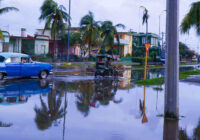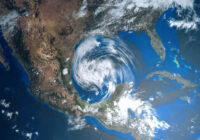Hurricanes Irma and Maria leave death and destruction across the Caribbean just weeks apart.
The 2017 hurricane season has been like no other seen in recent history. Hurricane Irma — a category 5 storm with the highest wind speeds ever recorded in the open Atlantic — ripped through the Caribbean in August, sowing death and destruction all the way from Barbuda to Miami. Just weeks later, Hurricane Maria brought more devastation to Martinique, Turks and Caicos Islands, Guadeloupe and the US Virgin Islands, with Puerto Rico and Dominica suffering most damage.
At least 27 lives were lost in Dominica, where Maria became the first category 5 hurricane to hit the island since records began in 1851. With over 80% of its buildings destroyed, Dominica’s Prime Minister Roosevelt Skerrit was moved to tears by the devastation, saying “we have lost all what money can buy and replace.” He made an impassioned appeal to the United Nations General Assembly on behalf of those nations hit hardest by climate change.
Slowing to a category 4 storm, Maria brought weather that Puerto Rico has not faced in nearly 80 years. The island is now depleted of fresh water, fuel and phone service, putting the territory on the brink of a humanitarian crisis. Insufficient sanitation is of major concern, and hospitals fear running out of fuel needed to keep life-support machines working. The island’s power grid may take as long as six months to restore. The storm has taken 16 lives so far, with at least 20 others missing.
Making a bad situation worse, Puerto Rico already faces a financial crisis with a massive $70 billion deficit, having declared bankruptcy in May. With an estimated $30 billion-worth of damages, 3.4 million American citizens on the island were left wanting of their president’s empathy. While Donald Trump noted almost a week after the devastation hit that the territory is in “deep trouble” and that he is “working hard,” there is yet to be a concrete commitment to a relief effort.
After getting through the storm and massive flooding, rescue is being sought out for those who have been left stranded without a roof over their heads or any basic necessities for survival. Even though some cities are starting to get help from humanitarian organizations, it could take years for the islands to rebuild and recover from Maria’s destruction.
The views expressed in this article are the author’s own and do not necessarily reflect Fair Observer’s editorial policy.
Photo Credit: Jean-Francois Manuel / Shutterstock.com
Support Fair Observer
We rely on your support for our independence, diversity and quality.
For more than 10 years, Fair Observer has been free, fair and independent. No billionaire owns us, no advertisers control us. We are a reader-supported nonprofit. Unlike many other publications, we keep our content free for readers regardless of where they live or whether they can afford to pay. We have no paywalls and no ads.
In the post-truth era of fake news, echo chambers and filter bubbles, we publish a plurality of perspectives from around the world. Anyone can publish with us, but everyone goes through a rigorous editorial process. So, you get fact-checked, well-reasoned content instead of noise.
We publish 2,500+ voices from 90+ countries. We also conduct education and training programs
on subjects ranging from digital media and journalism to writing and critical thinking. This
doesn’t come cheap. Servers, editors, trainers and web developers cost
money.
Please consider supporting us on a regular basis as a recurring donor or a
sustaining member.
Will you support FO’s journalism?
We rely on your support for our independence, diversity and quality.





